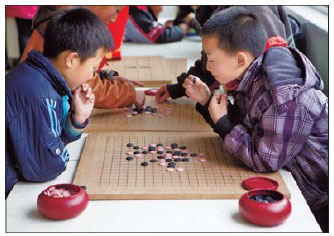

Thousands offered their services after quake in May 2008, and some remain, reports Gao Qihui in Sichuan.
The 8-magnitude earthquake struck Sichuan province at 2:28 pm on May 12, 2008. It killed at least 69,227 people and left more than 5 million homeless. Thousands of people poured in to the area to help, among them many foreigners - rescuers, charity workers, doctors, psychotherapists, construction engineers and general volunteers.
 Children play chess during break at a primary school in Mianzhu, Sichuan province. Foreigners have played a significant role in reconstruction efforts in the province that was hit by an 8-magnitude earthquake on May 12, 2008. Zhang Tao / China Daily |
Three foreigners who have been there since the disaster - an American, a Malaysian and a Singaporean - tell China Daily their stories in the earthquake-hit zone.
Initial goal makes way for one that succeeds
Roland Catellier was visiting his son about that time in Pensacola, Florida, 537 kilometers from his Tampa Bay home in the US Southeast. His son's question started him on a longer journey: "When will you start doing volunteer work again?"

Catellier, then 59, had spent 17 years traveling the world doing volunteer work. He had put that aside for some years to tend to family and business but the earthquake, and his son, started him thinking.
He determined his purpose - helping the homeless rebuild - and started the process of forming the Disaster Relief Shelters Foundation. He arrived in Chengdu, Sichuan province, in June 2008 and made a one-day visit to Mianzhu city, where the quake had killed at least 11,117 people and left more than 180,000 families homeless.
He was more impressed than shocked. Catellier had seen other disasters, including US hurricanes Andrew and Katrina, but in Mianzhu, temporary water facilities and banks were already operating. He found people who were busy and carrying on their lives.
Catellier initially wanted to donate houses to villagers. Through a Peking University professor he had met online, he was introduced to officials of Maoxian county, Aba Tibetan and Qiang autonomous prefectures in Sichuan.
He met the Maoxian officials in July and told them he wished to donate five small houses. But the officials were worried: What about the others who were homeless? Catellier couldn't afford to house them, too, so his first idea was set aside.
Not long after, someone who had attended the meeting with the Maoxian officials asked if Catellier could build homes for state-supported elderly people and finish a sample unit in November 2008. Catellier said he felt encouraged that he had made progress.

He went back to the United States for a month to attend to details and arrange for a sample unit, a prefabricated house made from structural insulated panels made in China. But when he returned to China in November, he learned that graves had been found on the building site and the project was canceled.
Eleven months later, Catellier found his real opportunity through Sichuan Quake Relief (SQR), which had been trying to build a community center in Shihe village of Mianzhu city. An agreement was reached: SQR would pay for the land and foundation, and Catellier would be responsible for everything above it, including the water system and insulation.
The construction began on May 6, 2010, and it included lightweight steel framing to make the building more earthquake-resistant. Catellier supervised the construction and trained local laborers. He injured his back during the construction of the roof, and it took him 10 days to recover, but Di Kang Le center opened on Sept 12, 2010. The 100-square-meter building is a meeting and activity center for villagers and also provides a meeting place for grassroots non-governmental organizations.
"Now we have a place for the elders to gather to chat with each other," a 63-year-old villager said.
"I am happy the center is used by so many people," Catellier said.
His Disaster Relief Shelters Foundation was recognized by US federal authorities in December 2008, and with persistence his constant approach, Catellier overcame multiple obstacles to reach his goal. "My attitude is that the impossible takes a little longer."
Now he is running a social enterprise in Chengdu to provide graduate students the opportunity to start an undertaking through a business-to-entrepreneur website. The enterprise, Catellier said, will use a significant portion of profit to "donate more small community centers or small school buildings to remote villages all over China."







